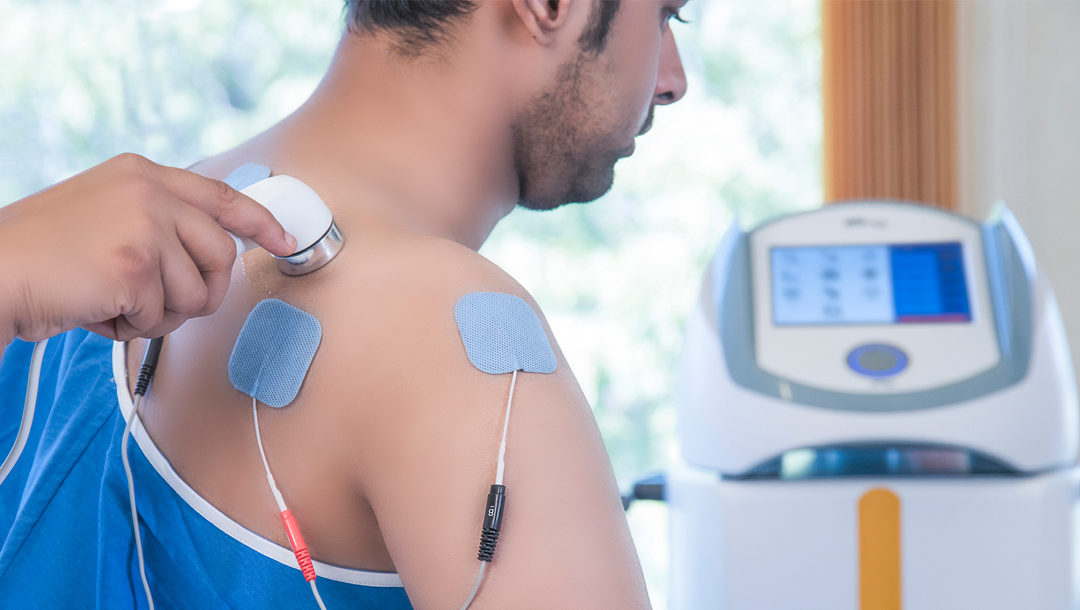
Electrotherapy supplies pain relief and inflammation reduction, in addition to improving physical function and mobility, being a versatile and guaranteed therapeutic choice.
Compared to other more invasive or pharmacological treatments, electrotherapy has fewer side effects and health risks. For this reason, more professionals and specialists are choosing to update their knowledge of this technique with degrees such as the Professional Master’s Degree Electrotherapy in Rehabilitation Medicine from TECH. Thus, they deepen in the combination of therapeutic approaches that supply synergistic results and perfect the benefits for health care.
Electrotherapy in Rehabilitation Medicine offers many advantages and health care benefits. This therapeutic modality uses low-intensity electrical currents to stimulate tissues and promote recovery from musculoskeletal injuries, relieving pain, reducing inflammation and accelerating the healing process. Therefore, when applied properly, physical function and mobility can be improved, contributing to a faster and more effective recovery.
It also stands out for its versatility and applicability in a wide range of health conditions, as it can be used in the treatment of sports injuries, chronic pain, neuromuscular disorders, postoperative conditions and other diseases affecting the musculoskeletal system. In addition, it can be adapted to the individual needs of patients, as there are different forms and techniques of application.
Advances in electrotherapy for more effective rehabilitation
There has been an increase in the development of ultramodern Neuromuscular Electrical Stimulation (NMES) technologies, which allow for more targeted and specific stimulation of muscles, easing a more precise approach to the treatment of neuromuscular conditions. For example, some NMES devices now feature high-definition electrodes that allow targeted stimulation of specific muscle areas, which can be beneficial for the rehabilitation of localized injuries or to improve function in specific muscle groups.
Another important trend is the use of electrotherapy in combination with other complementary therapies, such as physical therapy and therapeutic exercise. For example, electrotherapy devices have been developed that can be used with specific exercises, allowing active stimulation during functional movements.
In addition, personalization of treatments is another prominent trend in electrotherapy. Systems with real-time monitoring and feedback capabilities are being developed, allowing the intensity and frequency of stimulation to be adapted and adjusted according to the individual needs and responses of each patient.
Recovery, wellness and functional improvement
Electrotherapy offers a wide range of health care benefits, encompassing physical rehabilitation as well as pain relief and healing promotion. In this case, electrotherapy can help reduce pain noninvasively through electrical stimulation provided during treatments that can block pain signals and promote the release of endorphins.
In addition, it can improve blood circulation and lymphatic flow, which in turn promotes tissue healing, helping to increase the supply of oxygen and nutrients to damaged tissues, accelerating regeneration and the healing process. This can be beneficial for musculoskeletal injuries, wounds, pressure ulcers and other conditions where improved circulation is crucial.
Another important benefit is its ability to stimulate muscle contraction, being useful for strengthening and re-educating muscles that are weakened or affected by injuries or neuromuscular diseases. In addition, it can help improve motor control and muscle coordination, which contributes to a more complete and functional recovery.
TECH Technological University
TECH Technological University has set up its leading position in the field of digital education, offering students from all over the world the opportunity to access high-quality education, characterized by its global reputation based on an extensive catalog of more than 10,000 academic programs covering diverse areas of study.
Each year the university attracts over 100,000 new students, highlighting its ability to supply relevant education tailored to the demands of today’s job market, which has a network of over 500,000 graduates in over 150 countries.
The institution’s educational programs are characterized by their quality and relevance, equipping students with the knowledge and skills necessary to excel in their professional careers. This is thanks to its interactive experience combined with its focus on employability, positioning its graduates as highly valued professionals prepared to face the challenges of today’s job market.
